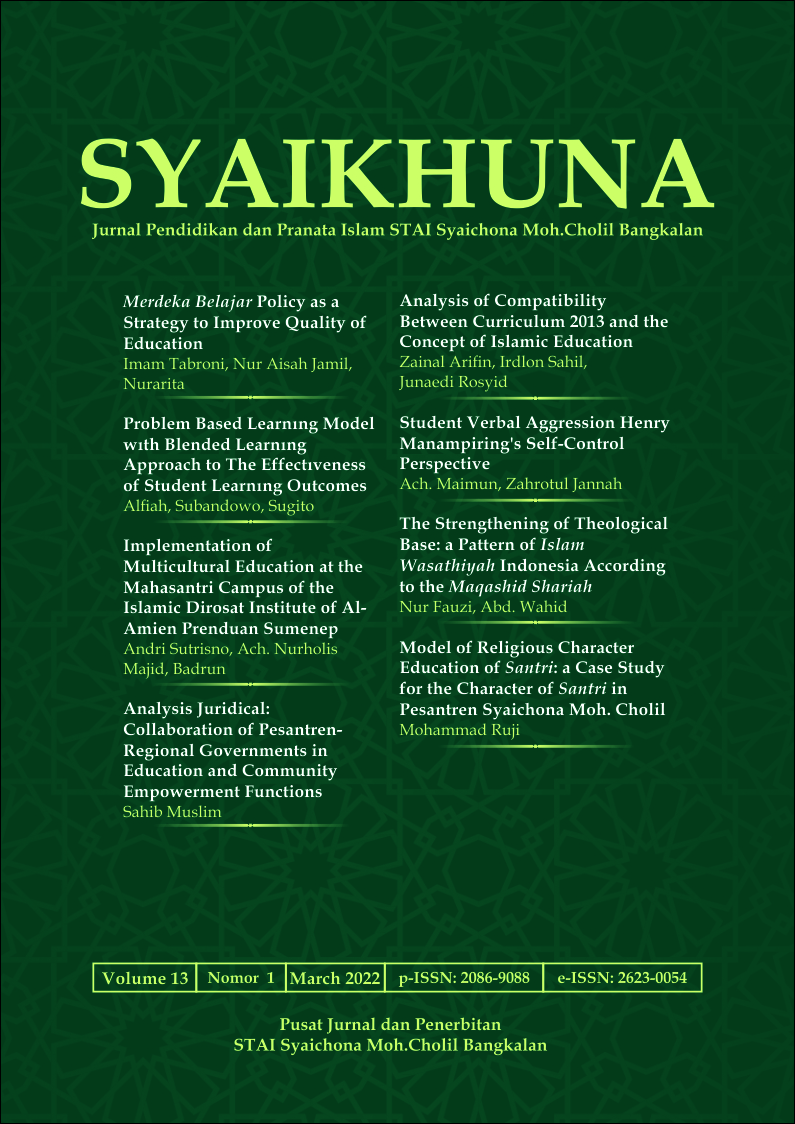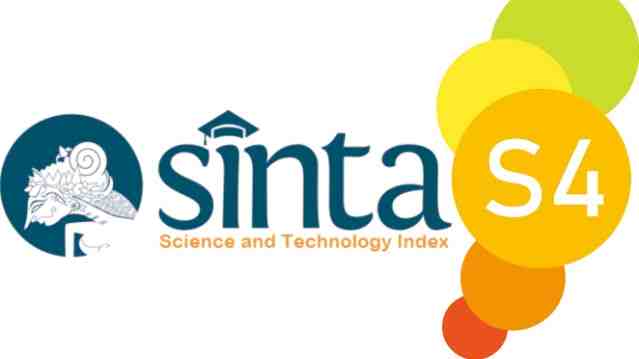Problem Based Learnıng Model wıth Blended Learnıng Approach to The Effectıveness of Student Learnıng Outcomes
DOI:
https://doi.org/10.36835/syaikhuna.v13i01.5535Keywords:
Problem Based Learning, blended learning, model, learning outcomes.Abstract
The low completion of student learning in a subject is the reality of the quality of education in schools. The model in learning is one of the factors that can cause an impact on students' learning achievements. The use of the learning model must be adjusted to the characteristics of the student himself and the subjects taught. This article is intended to reveal the differences in blended-based Problem Based Learning (PBL) learning and Problem Based Learning (PBL) learning to the learning outcomes of students of Class X at SMK Negeri in Bangkalan and describe the influence of interaction between blended-based Problem Based Learning (PBL) learning model and learning motivation for the learning outcomes of students of Class X at SMK Negeri in Bangkalan.. This research used quantitative research with experimental methods. In this case, it used two tools, namely questionnaire survey and learning result test. The experimental classes in this study used the blended-based Problem Based Learning (PBL) model conducted online learning and offline and face-to-face learning, while the control classes used the PBL (Problem Based Learning) model for face-to-face learning. This quantitative research used the data analysis technique through the two-way variant analysis (ANOVA) technique. The results showed that the baseline estimate of student learning outcome using the PBL learning model was 40, the highest score was 90, the average score was 72.33, and the standard deviation was 16,439. Compared to the learning outcome of students who used the problem-based learning (PBL) model the lowest score was 45, the highest score was 95, the average score was 80.67, and the standard deviation was 11,502. Seeing from the results of the exploration, it can be concluded that the results of the blended-based Problem Based Learning model are higher, or in other words, students' learning outcomes become more effective by using the approach.References
Altintas, E., Karaca, Y., Moustafa, A., & El Haj, M. (2020). Effect of Best Possible Self Intervention on Situational Motivation and Commitment in Academic Context. Learning and Motivation, 69, 101599.
Andriyati, S., Kuswarini, P., & Surahman, E. (2020). Perbedaan Hasil Belajar Siswa Yang Menggunakan Model Pembelajaran Project Based Learning Dan Problem Based Learning. Geoducation, 1(1).
Arham, U. U., & Dwiningsih, K. (2016). Keefektifan Multimedia Interaktif Berbasis Blended Learning untuk Meningkatkan Hasil Belajar Siswa. Kwangsan, 4(2).
Arrosagaray, M., González-Peiteado, M., Pino-Juste, M., & RodrÃguez-López, B. (2019).
Blau, I., Shamir-Inbal, T., & Avdiel, O. (2020). How does the pedagogical design of a technology-enhanced collaborative academic course promote digital literacies, self-regulation, and perceived learning of students? The Internet and Higher Education, 45, 100722. https://doi.org/10.1016/j.iheduc.2019.100722
Fatirul, A. N. (2012). Pengaruh Strategi Pembelajaran (Problem-Based Learning Berbantuan dan Tanpa Berbantuan Internet) dan Gaya Kognitif Terhadap Prestasi Belajar.(Disertasi). Disertasi Dan Tesis Program Pascasarjana UM.
Fatirul, A. N. (2020). Online Application Development in Blended Learning to Increase Ease of Collaboration and Communication, and Students’ Freedom of Thought Ability. Online Learning, 3(5).
Fatirul, A. N., ST, M. P., Walujo, D. A., & ST, M. (2020). Desain Blended Learning: Desain Pembelajaran Online Hasil Penelitian. Scopindo Media Pustaka.
Ismail, J. (2019). Meningkatkan Motivasi Belajar Bahasa Indonesia Melalui Interaksi Edukatif Siswa Kelas Viii Smp Negeri 5 Kota Ternate. E-Jurnal Mitra Pendidikan, 3(8), 1105–1120.
Jannah, M. (2019). Pengaruh Penerapan Model Blended Learning Terhadap Tingkat Pemahaman Siswa Smp Pada Mata Pelajaran Ips Kelas Vii Tahun 2019.
Kintu, M. J., Zhu, C., & Kagambe, E. (2017). Blended learning effectiveness: The relationship between student characteristics, design features and outcomes. International Journal of Educational Technology in Higher Education, 14(1), 7. https://doi.org/10.1186/s41239-017-0043-4
Kopeyev, Z., Mubarakov, A., Kultan, J., Aimicheva, G., & Tuyakov, Y. (2020). Using a Personalized Learning Style and Google Classroom Technology to Bridge the Knowledge Gap on Computer Science. International Journal of Emerging Technologies in Learning (IJET), 15(02), 218–229.
Nguyen, G. N. (2019). Teaching the Law of Cosines in Advanced 10th Grade Geometry Textbook by Way of Problem-Based Learning in Vietnam. International Journal of Learning, Teaching and Educational Research, 18(11), 397–413.
Porter, W. W., & Graham, C. R. (2016). Institutional drivers and barriers to faculty adoption of blended learning in higher education. British Journal of Educational Technology, 47(4), 748–762.
Rufii, R., & Rochmawati, D. (2019). Evaluation of universal design for constructivist-based statistics learning module for students’ increased motivation. Journal of Education and Learning (EduLearn), 13(3), 431–440. https://doi.org/10.11591/edulearn.v13i3.9174
Sasmito, A., Suciati, S., & Mariadi, M. (2017). Profile of Communication Skills in Biology For XI Grade Students of “Y†Senior High School in Madiun Regency. Unnes Science Education Journal, 6(2).
Sasongko, D. B., & Fatirul, N. (2019). Pengembangan E-Learning Dengan Video Conference Untuk Pendukung Pembelajaran Informatika Terapan Di Politeknik Kelautan Dan Perikanan Sidoarjo. Jurnal Education And Development, 7(2), 236–236.
Semler, S. (2005). Use blended learning to increase learner engagement and reduce training cost. On-Line) Dalam Http://Www. Learningsim. Com/Content/Lsnews/Blended_learning1. Html. Diunduh, 11.
Septiani, U. U., Degeng, I. N. S., & Sitompul, N. C. (2020). Development of Problem Based Learning Book for Indonesian Language and Literature Subject at Junior High School". Jurnal Dimensi Pendidikan Dan Pembelajaran, 8(2), 91–102. https://doi.org/10.24269/dpp.v8i2.2194
Siregar, S. (2013). Meningkatkan Pemahaman dan Hasil Belajar Siswa Pada Mata Pelajaran Matematika dengan Menggunakan Software Graphmatica. Edumatica: Jurnal Pendidikan Matematika, 3(01).
Subandowo, S. (2015). Kebijakan Pendidikan Teori & Praktik. Wineka Media.
Sugito, Sugito. (2017). Kapita Selekta teknologi pendidikan dan problematika pendidikan. Adi Buana University Press.
Sugiyono, P. (2011). Metodologi penelitian kuantitatif kualitatif dan R&D. Alpabeta, Bandung.
Sugiyono, P. D. (2009). Metode Penelitian Kuantitatif Kualitatif Dan R &D, Alfabeta. Denzin, NK, & Lincoln, S. Yvonna.
Thai, N. T. T., De Wever, B., & Valcke, M. (2017). The impact of a flipped classroom design on learning performance in higher education: Looking for the best “blend†of lectures and guiding questions with feedback. Computers & Education, 107, 113–126.
Downloads
Published
How to Cite
Issue
Section
License
Copyright (c) 2022 Alfiah Afiah, Subandowo Subandowo, Sugito Sugito

This work is licensed under a Creative Commons Attribution 4.0 International License.





